Research into the Optimal Regulation of the Groundwater Table and Quality in the Southern Plain of Beijing Using Geographic Information Systems Data and Machine Learning Algorithms
Abstract
1. Introduction
2. Materials and Methods
2.1. Study Area
2.2. Data Sources
2.2.1. Groundwater Table and Quality Data
2.2.2. Statistical Data
2.3. Research Method
2.3.1. Forecast of Water Demand
- Forecast of domestic water demand
- Forecast of industrial water demand
- Forecast of agricultural water demand
- Forecast of ecological water demand
2.3.2. Machine Learning Algorithms
2.3.3. Optimal Allocation Model for Water Resources
- Objective function
- Constraint condition
- Model solution
2.3.4. Numerical Simulation of Groundwater Flow
- Zoning generalization of hydrogeological parameters
- Boundary condition generalization
- Mathematical model establishment
- Mathematical model solution
- Model identification and validation
- Processing of Source and Sink Items
- 2.
- Model Identification and Verification
3. Results and Discussion
3.1. Forecast of NO3-N Concentration
3.2. Optimal Allocation of Water Resources
3.3. Changes in NO3-N Pollution before and after Optimal Regulation
3.4. Changes in the Groundwater Table before and after Optimal Regulation
4. Conclusions
- (1)
- ArcGIS was used to generate Thiessen polygons around 25 water quality monitoring points. The regional analysis tool in ArcGIS was then used to extract the water consumption and economic development data for each polygon. Finally, three machine-learning algorithms were used to predict the NO3-N pollution under three different hydrological year scenarios for the Daxing District. The results show that LSTM had better accuracy than RF and SVR. Therefore, further research on the combination of GIS and LSTM has high theoretical and practical value.
- (2)
- According to our model’s predictions of future groundwater NO3-N pollution, this form of pollution shows an increasing trend in Daxing under the existing urban development regime. As compared with 2016–2020, the NO3-N pollution of groundwater over the period from 2021–2025 increased from 14.05 mg/L to 14.87 mg/L, 15.64 mg/L, and 16.54 mg/L in wet year, normal year, and dry year scenarios, respectively. It can be seen that the prediction pollution of pollution in the dry 2025 scenario was the most serious.
- (3)
- Taking 2025 as the example year for which to assess prospective mitigations of NO3-N pollution of groundwater, three new groundwater exploitation regimes were devised. A model for the optimal allocation of water resources was applied to the task of optimizing groundwater use under the three new regimes. The optimization results showed that of these new regimes, groundwater exploitation regime 3 should be adopted in a wet year and a normal year and that regime 1 should be adopted in a dry year.
- (4)
- Taking 2025 as the test year once more, we used ArcGIS to plot the changes in NO3-N pollution before and after optimization in wet year, normal year, and dry year scenarios. The results showed that the concentration of NO3-N decreased significantly after regime optimization. For the northern region of Daxing, which was the most polluted, the concentration of NO3-N decreased from 15.40 mg/L, 15.82 mg/L, and 16.42 mg/L to 6.31 mg/L, 6.61 mg/L, and 7.93 mg/L in the wet year, normal year, and dry year scenarios, respectively.
- (5)
- Taking 2025 as the test year for a third time, the Modflow model was used to simulate changes in the groundwater level before and after optimization and regulation. The results showed that the average groundwater table rose by 0.99 m, 1.80 m, and 2.07 m in the wet year, normal year, and dry year scenarios, respectively.
Supplementary Materials
Author Contributions
Funding
Institutional Review Board Statement
Informed Consent Statement
Data Availability Statement
Acknowledgments
Conflicts of Interest
References
- Wang, S.J.; Ma, H.T.; Zhao, Y.B. Exploring the relationship between urbanization and the eco-environment-A case study of Beijing-Tianjin-Hebei region. Ecol. Indic. 2014, 45, 171–183. [Google Scholar] [CrossRef]
- Wu, W.J.; Zhao, S.Q.; Zhu, C.; Jiang, J.L. A comparative study of urban expansion in Beijing, Tianjin and Shijiazhuang over the past three decades. Landsc. Urban Plan. 2015, 134, 93–106. [Google Scholar] [CrossRef]
- Hubacek, K.; Guan, D.B.; Barrett, J.; Wiedmann, T. Environmental implications of urbanization and lifestyle change in China: Ecological and Water Footprints. J. Clean Prod. 2009, 17, 1241–1248. [Google Scholar] [CrossRef]
- Chen, B.B.; Gong, H.L.; Li, X.J.; Lei, K.C.; Zhu, L.; Gao, M.L.; Zhou, C.F. Characterization and causes of land subsidence in Beijing, China. Int. J. Remote Sens. 2017, 38, 808–826. [Google Scholar] [CrossRef]
- Chen, J.; Tang, C.; Sakura, Y.; Yu, J.; Fukushima, Y. Nitrate pollution from agriculture in different hydrogeological zones of the regional groundwater flow system in the North China Plain. Hydrogeol. J. 2005, 13, 481–492. [Google Scholar] [CrossRef]
- Malczewski, J. GIS-based land-use suitability analysis: A critical overview. Prog. Plann. 2004, 62, 3–65. [Google Scholar] [CrossRef]
- Singh, A. Managing the water resources problems of irrigated agriculture through geospatial techniques: An overview. Agr. Water Manag. 2016, 174, 2–10. [Google Scholar] [CrossRef]
- Yang, X.J. Remote sensing and GIS applications for estuarine ecosystem analysis: An overview. Int. J. Remote Sens. 2005, 26, 5347–5356. [Google Scholar] [CrossRef]
- Garg, J.K. Wetland assessment, monitoring and management in India using geospatial techniques. J. Env. Manag. 2015, 148, 112–123. [Google Scholar] [CrossRef]
- Zhou, J.; Wang, Y.Y.; Xiao, F.; Wang, Y.Y.; Sun, L.J. Water Quality Prediction Method Based on IGRA and LSTM. Water 2018, 10, 1148. [Google Scholar] [CrossRef]
- Parmar, K.S.; Bhardwaj, R. Water quality management using statistical analysis and time-series prediction model. Appl. Water Sci. 2014, 4, 425–434. [Google Scholar] [CrossRef]
- Asgari, G.; Gholi, M.N.; Salari, M.; Asgharnia, H.; Darvishmotevalli, M.; Faraji, H.; Moradnia, M. Forecasting nitrate concentration in babol groundwater resources using the grey model (1,1). Int. J. Environ. Health Eng. 2020, 9, 16. [Google Scholar] [CrossRef]
- Parmar, K.S.; Bhardwaj, R. River Water Prediction Modeling Using Neural Networks, Fuzzy and Wavelet Coupled Model. Water Resour. Manag. 2015, 29, 17–33. [Google Scholar] [CrossRef]
- Guner, E.D.; Kuvvetli, Y. Analysis of groundwater quality for drinking purposes using combined artificial neural networks and fuzzy logic approaches. Desalin Water Treat. 2020, 174, 143–151. [Google Scholar] [CrossRef]
- Li, J.; Li, X.; Lv, N.Q.; Yang, Y.; Xi, B.D.; Li, M.X.; Bai, S.G.; Liu, D. Quantitative assessment of groundwater pollution intensity on typical contaminated sites in China using grey relational analysis and numerical simulation. Environ. Earth Sci. 2015, 74, 3955–3968. [Google Scholar] [CrossRef]
- Yang, W.; Zhang, K.N.; Chen, Y.G.; Zhou, X.Z.; Jin, F.X. Prediction on contaminant migration in aquifer of fractured granite substrata of landfill. J. Cent. South Univ. 2013, 20, 3193–3201. [Google Scholar] [CrossRef]
- Agrawal, P.; Sinha, A.; Kumar, S.; Agarwal, A.; Banerjee, A.; Villuri, V.; Annavarapu, C.; Dwivedi, R.; Dera, V.; Sinha, J.; et al. Exploring Artificial Intelligence Techniques for Groundwater Quality Assessment. Water 2021, 13, 1172. [Google Scholar] [CrossRef]
- Ahmadi, A.; Olyaei, M.; Heydari, Z.; Emami, M.; Zeynolabedin, A.; Ghomlaghi, A.; Daccache, A.; Fogg, G.E.; Sadegh, M. Groundwater Level Modeling with Machine Learning: A Systematic Review and Meta-Analysis. Water 2022, 14, 949. [Google Scholar] [CrossRef]
- Patle, G.T.; Singh, D.K.; Sarangi, A.; Rai, A.; Khanna, M.; Sahoo, R.N. Time Series Analysis of Groundwater Levels and Projection of Future Trend. J. Geol. Soc. India 2015, 85, 232–242. [Google Scholar] [CrossRef]
- Zhang, X.; Li, P.; Bin Li, Z.; Yu, G.Q. Soil water-salt dynamics state and associated sensitivity factors in an irrigation district of the loess area: A case study in the Luohui Canal Irrigation District, China. Environ. Earth Sci. 2017, 76, 715. [Google Scholar] [CrossRef]
- Nazari, H.; Taghavi, B.; Hajizadeh, F. Groundwater salinity prediction using adaptive neuro-fuzzy inference system methods: A case study in Azarshahr, Ajabshir and Maragheh plains, Iran. Environ. Earth Sci. 2021, 80, 152. [Google Scholar] [CrossRef]
- Liu, F.M.; Yi, S.P.; Ma, H.Y.; Huang, J.Y.; Tang, Y.K.; Qin, J.B.; Zhou, W.H. Risk assessment of groundwater environmental contamination: A case study of a karst site for the construction of a fossil power plant. Environ. Sci. Pollut. R. 2019, 26, 30561–30574. [Google Scholar] [CrossRef] [PubMed]
- Aghlmand, R.; Abbasi, A. Application of MODFLOW with Boundary Conditions Analyses Based on Limited Available Observations: A Case Study of Birjand Plain in East Iran. Water 2019, 11, 1904. [Google Scholar] [CrossRef]
- Kouadri, S.; Elbeltagi, A.; Islam, A.; Kateb, S. Performance of machine learning methods in predicting water quality index based on irregular data set: Application on Illizi region (Algerian southeast). Appl. Water Sci. 2021, 11, 190. [Google Scholar] [CrossRef]
- Sun, J.; Wang, G.H. Geographic Information System Technology Combined with Back Propagation Neural Network in Groundwater Quality Monitoring. Isprs. Int. J. Geo-Inf. 2020, 9, 736. [Google Scholar] [CrossRef]
- Setshedi, K.J.; Mutingwende, N.; Ngqwala, N.P. The Use of Artificial Neural Networks to Predict the Physicochemical Characteristics of Water Quality in Three District Municipalities, Eastern Cape Province, South Africa. Int. J. Env. Res. Pub. He. 2021, 18, 5248. [Google Scholar] [CrossRef] [PubMed]
- Yoon, H.; Hyun, Y.; Ha, K.; Lee, K.K.; Kim, G.B. A method to improve the stability and accuracy of ANN- and SVM-based time series models for long-term groundwater level predictions. Comput. Geosci. 2016, 90, 144–155. [Google Scholar] [CrossRef]
- Liang, Z.H.; Liu, Y.P.; Hu, H.C.; Li, H.Q.; Ma, Y.Q.; Khan, M. Combined Wavelet Transform with Long Short-Term Memory Neural Network for Water Table Depth Prediction in Baoding City, North China Plain. Front. Environ. Sci. 2021, 78, 565. [Google Scholar] [CrossRef]
- Gupta, P.K.; Maiti, S. Enhancing data-driven modeling of fluoride concentration using new data mining algorithms. Environ. Earth Sci. 2022, 81, 89. [Google Scholar] [CrossRef]
- Aldhyani, T.H.H.; Al-Yaari, M.; Alkahtani, H.; Maashi, M.; Algalil, F.A. Water Quality Prediction Using Artificial Intelligence Algorithms. Appl. Bionics. Biomech. 2020, 2020, 6659314. [Google Scholar] [CrossRef]
- Kumar, S.; Pati, J. Assessment of groundwater arsenic contamination using machine learning in Varanasi, Uttar Pradesh, India. J. Water Health 2022, 20, 829–848. [Google Scholar] [CrossRef] [PubMed]
- Islam, A.R.M.T.; Pal, S.C.; Chakrabortty, R.; Idris, A.M.; Salam, R.; Islam, M.S.; Zahid, A.; Shahid, S.; Ismail, Z.B. A coupled novel framework for assessing vulnerability of water resources using hydrochemical analysis and data-driven models. J. Clean Prod. 2022, 336, 130407. [Google Scholar] [CrossRef]
- Rodriguez-Galiano, V.; Mendes, M.P.; Garcia-Soldado, M.J.; Chica-Olmo, M.; Ribeiro, L. Predictive modeling of groundwater nitrate pollution using Random Forest and multisource variables related to intrinsic and specific vulnerability: A case study in an agricultural setting (Southern Spain). Sci. Total Environ. 2014, 476–477, 189–206. [Google Scholar] [CrossRef] [PubMed]
- Norouzi, H.; Moghaddam, A.A. Groundwater quality assessment using random forest method based on groundwater quality indices (case study: Miandoab plain aquifer, NW of Iran). Arab. J. Geosci. 2020, 13, 912. [Google Scholar] [CrossRef]
- Arabgol, R.; Sartaj, M.; Asghari, K. Predicting Nitrate Concentration and Its Spatial Distribution in Groundwater Resources Using Support Vector Machines (SVMs) Model. Environ. Model Assess. 2016, 21, 71–82. [Google Scholar] [CrossRef]
- Dixon, B. A case study using support vector machines, neural networks and logistic regression in a GIS to identify wells contaminated with nitrate-N. Hydrogeol. J. 2009, 17, 1507–1520. [Google Scholar] [CrossRef]
- Xiao, Y.; Liu, K.; Hao, Q.; Xiao, D.; Zhu, Y.; Yin, S.; Zhang, Y. Hydrogeochemical insights into the signatures, genesis and sustainable perspective of nitrate enriched groundwater in the piedmont of Hutuo watershed, China. Catena 2022, 212, 106020. [Google Scholar] [CrossRef]
- Dai, C.; Tang, J.; Li, Z.; Duan, Y.; Qu, Y.; Yang, Y.; Lyu, H.; Zhang, D.; Wang, Y. Index System of Water Resources Development and Utilization Level Based on Water-Saving Society. Water 2022, 14, 802. [Google Scholar] [CrossRef]
- Liu, J.; Zhao, X.; Yang, H.; Liu, Q.; Xiao, H.; Cheng, G. Assessing China’s “developing a water-saving society” policy at a river basin level: A structural decomposition analysis approach. J. Clean. Prod. 2018, 190, 799–808. [Google Scholar] [CrossRef]
- Du, M.; Liao, L.; Wang, B.; Chen, Z. Evaluating the effectiveness of the water-saving society construction in China: A quasi-natural experiment. J. Environ. Manag. 2021, 277, 111394. [Google Scholar] [CrossRef]
- Hochreiter, S. The vanishing gradient problem during learning recurrent neural nets and problem solutions. Int. J. Uncertain. Fuzziness Knowl.-Based Syst. 1998, 6, 107–116. [Google Scholar] [CrossRef]
- Hochreiter, S.; Schmidhuber, J. Long Short-Term Memory. Neural Comput. 1997, 9, 1735–1780. [Google Scholar] [CrossRef] [PubMed]
- Breiman, L. Random Forests. Mach. Learn 2001, 45, 5–32. [Google Scholar] [CrossRef]
- Das, S.; Chakraborty, R.; Maitra, A. A random forest algorithm for nowcasting of intense precipitation events. Adv. Space Res. 2017, 60, 1271–1282. [Google Scholar] [CrossRef]
- Nashwan, M.S.; Shahid, S. Symmetrical uncertainty and random forest for the evaluation of gridded precipitation and temperature data. Atmos. Res. 2019, 230, 104632. [Google Scholar] [CrossRef]
- Wang, X.; Zhong, Y. Statistical learning theory and state of the art in SVM. In Proceedings of the Second IEEE International Conference on Cognitive Informatics, 2003. Proceedings, London, UK, 18–20 August 2003; pp. 55–59. [Google Scholar] [CrossRef]
- Ngatchou, P.; Zarei, A.; El-Sharkawi, A. Pareto Multi Objective Optimization. In Proceedings of the 13th International Conference on, Intelligent Systems Application to Power Systems, Arlington, VA, USA, 6–10 November 2005; pp. 84–91. [Google Scholar] [CrossRef]
- Deb, K.; Pratap, A.; Agarwal, S.; Meyarivan, T. A fast and elitist multiobjective genetic algorithm: NSGA-II. IEEE T. Evolut. Comput. 2002, 6, 182–197. [Google Scholar] [CrossRef]
- Alagha, J.S.; Said, M.A.M.; Mogheir, Y. Modeling of nitrate concentration in groundwater using artificial intelligence approach—a case study of Gaza coastal aquifer. Environ. Monit. Assess. 2014, 186, 35–45. [Google Scholar] [CrossRef]
- Nadali, A.; Ebrahim, Z.; Morteza, H.; Ali, A.B.; Gholamreza, G.; Ahmad, R.Y.; Mohammad, J.M. Water quality assessment and zoning analysis of Dez eastern aquifer by Schuler and Wilcox diagrams and GIS. Desalin. Water Treat. 2016, 57, 23686–23697. [Google Scholar]

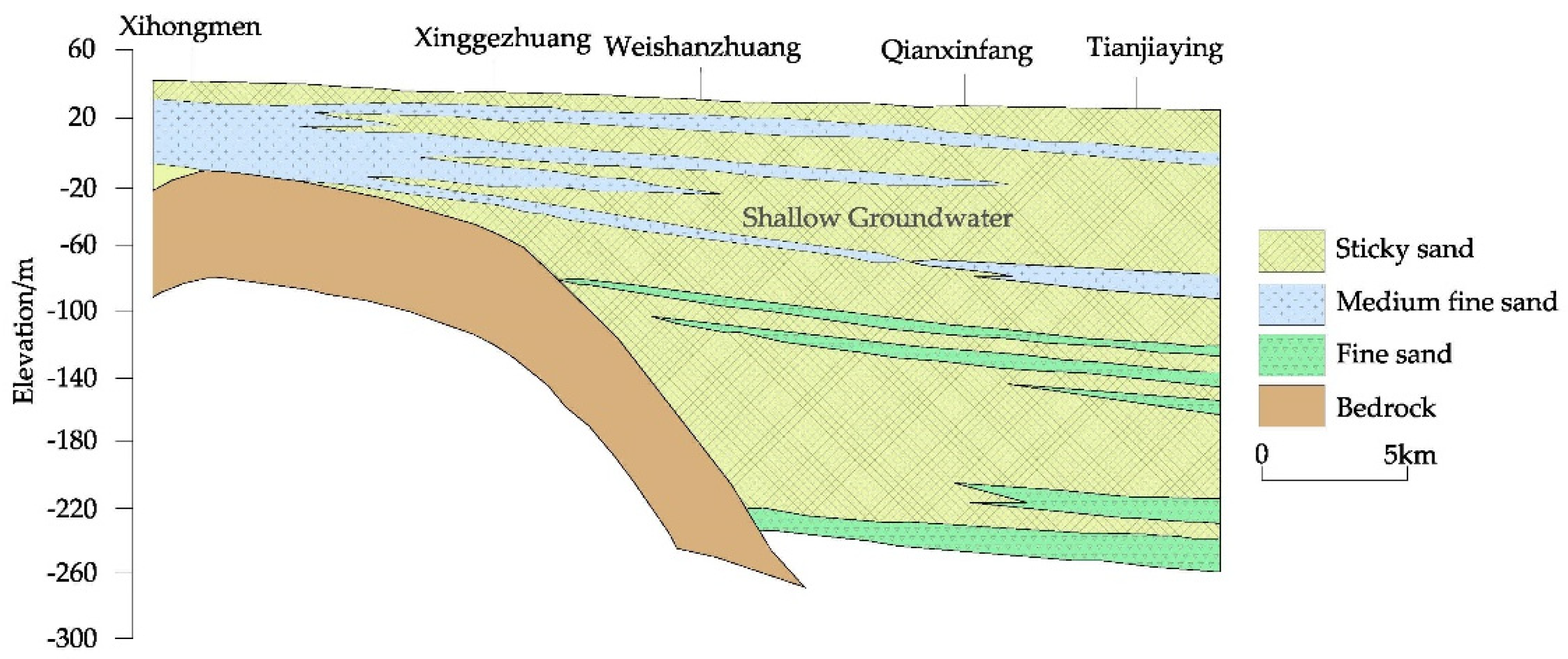
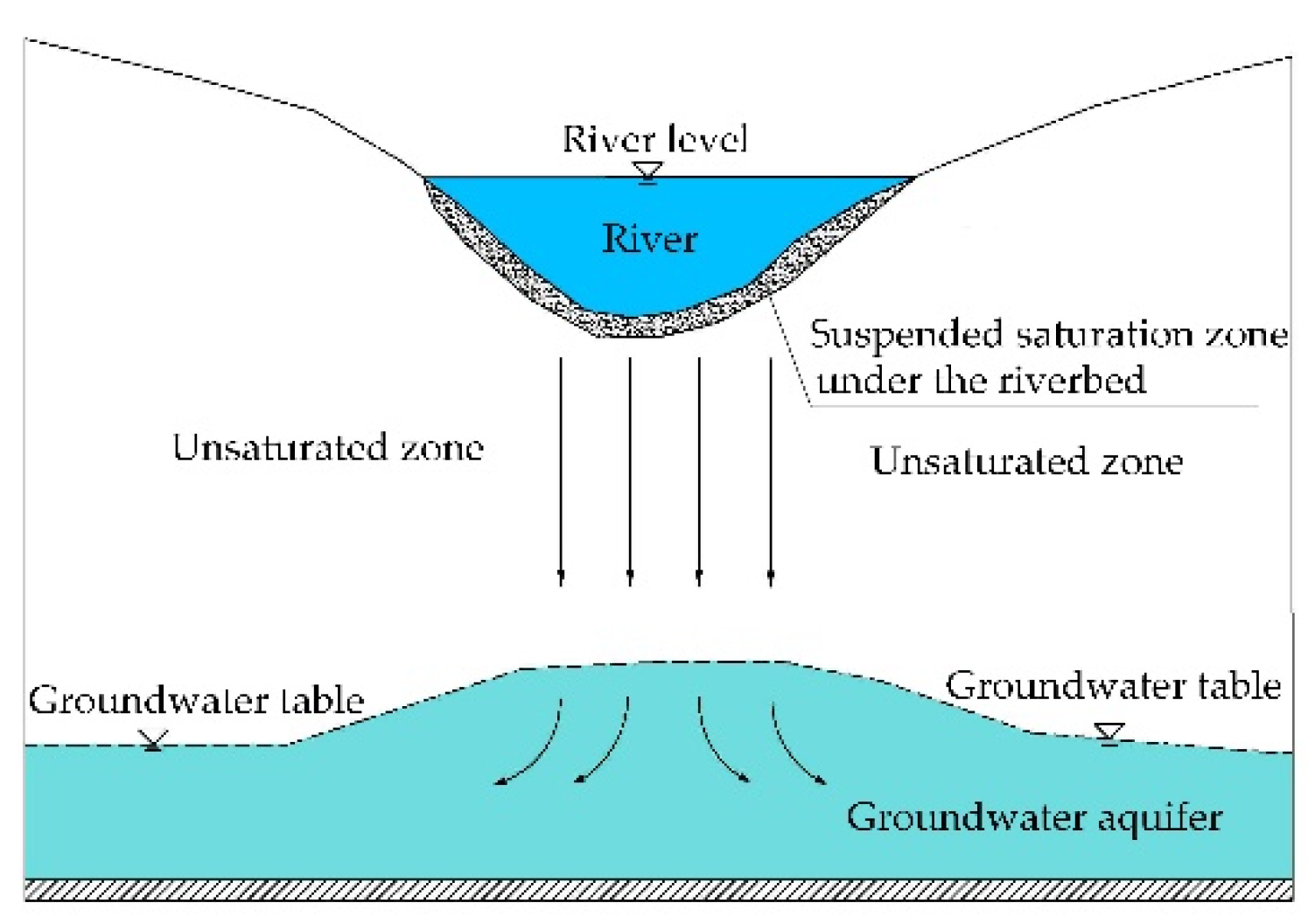

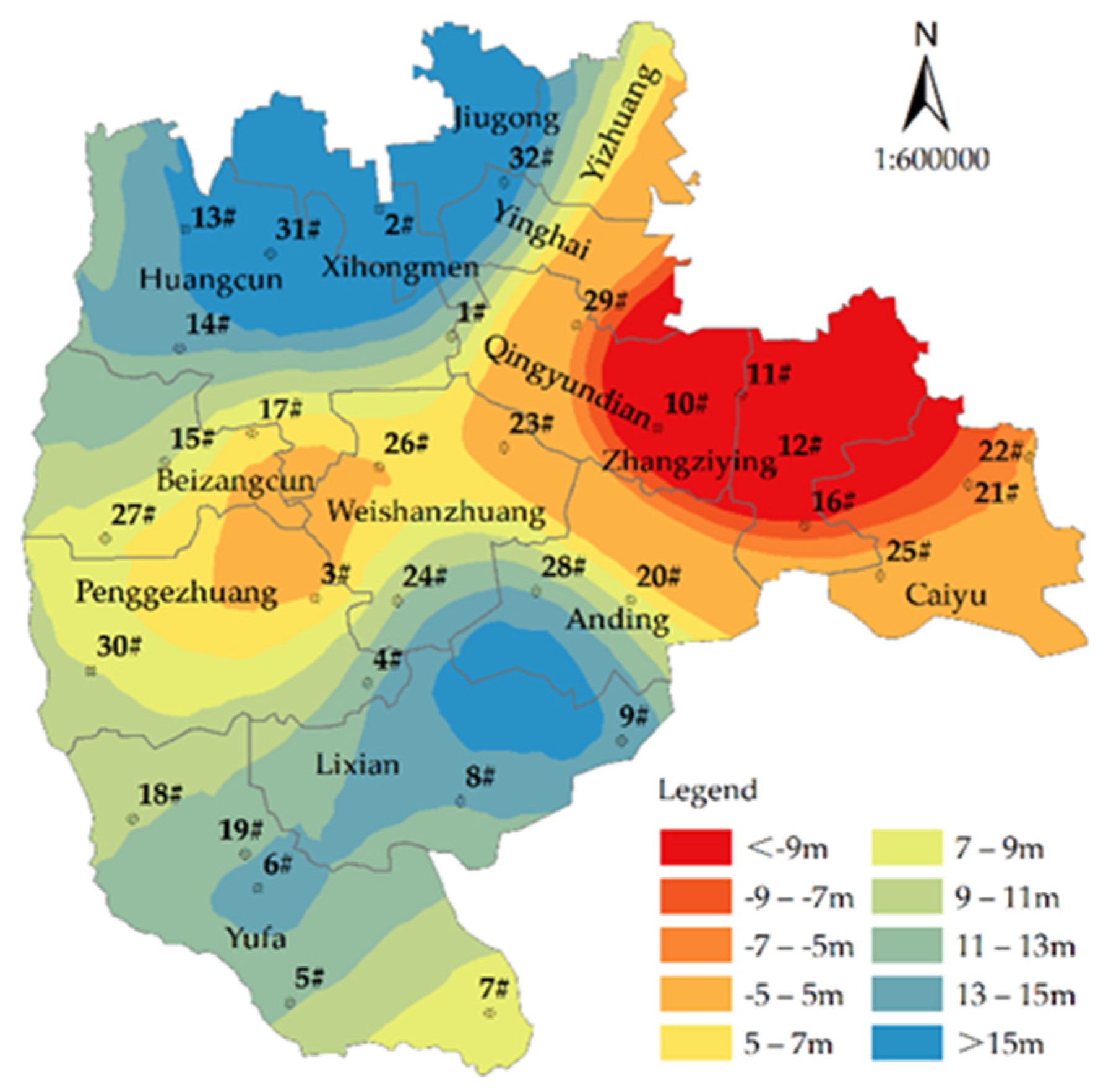
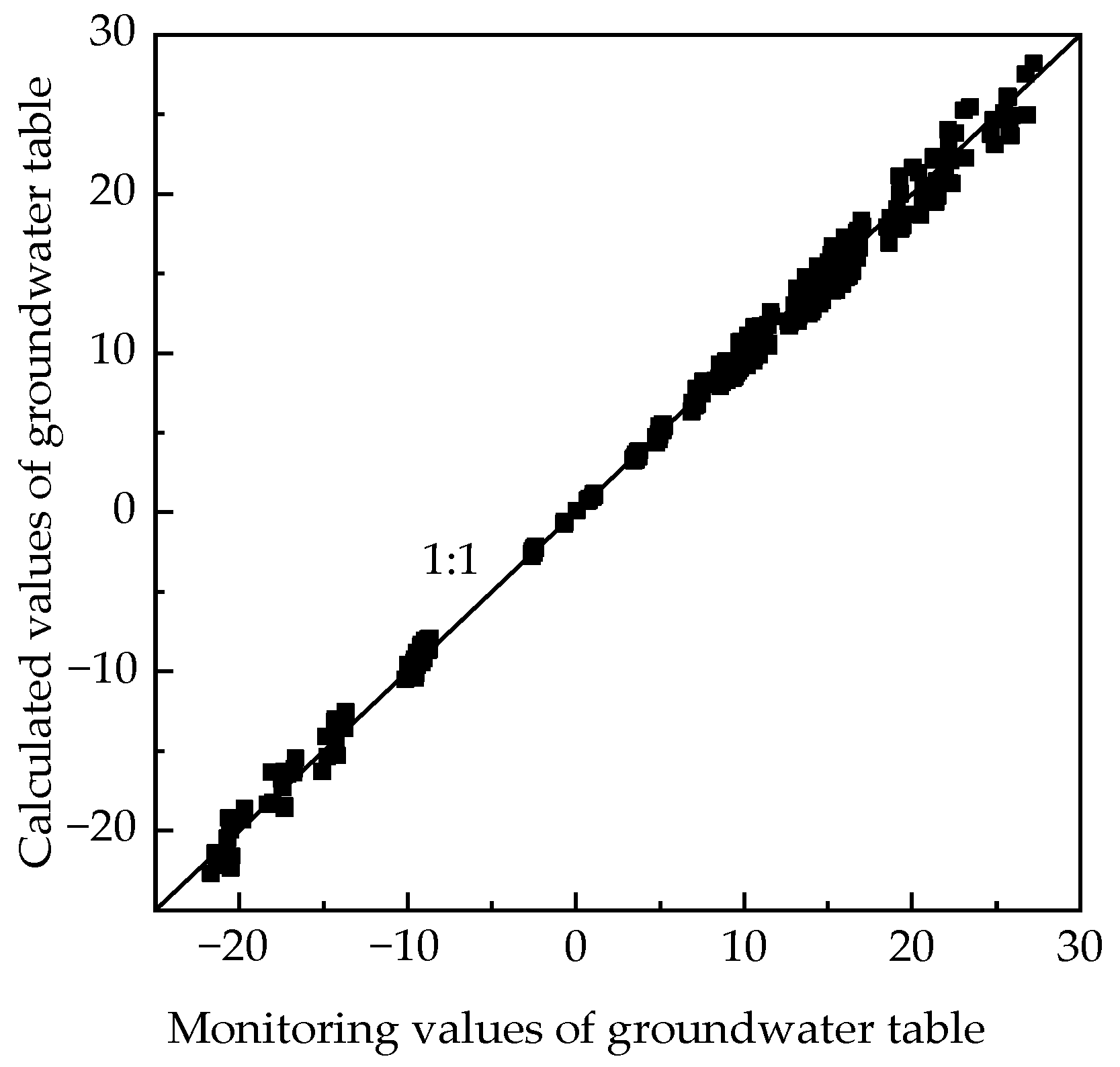
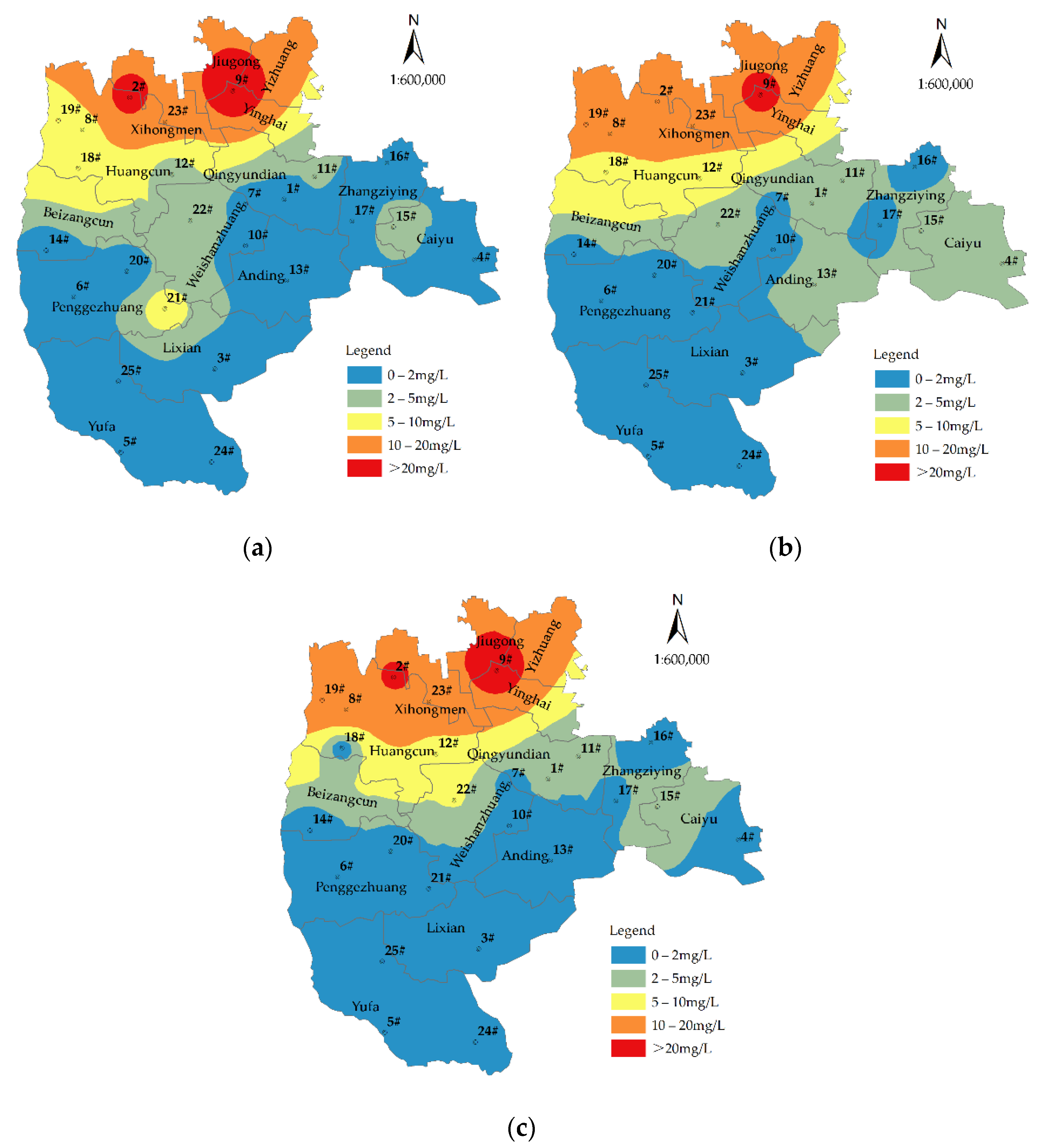
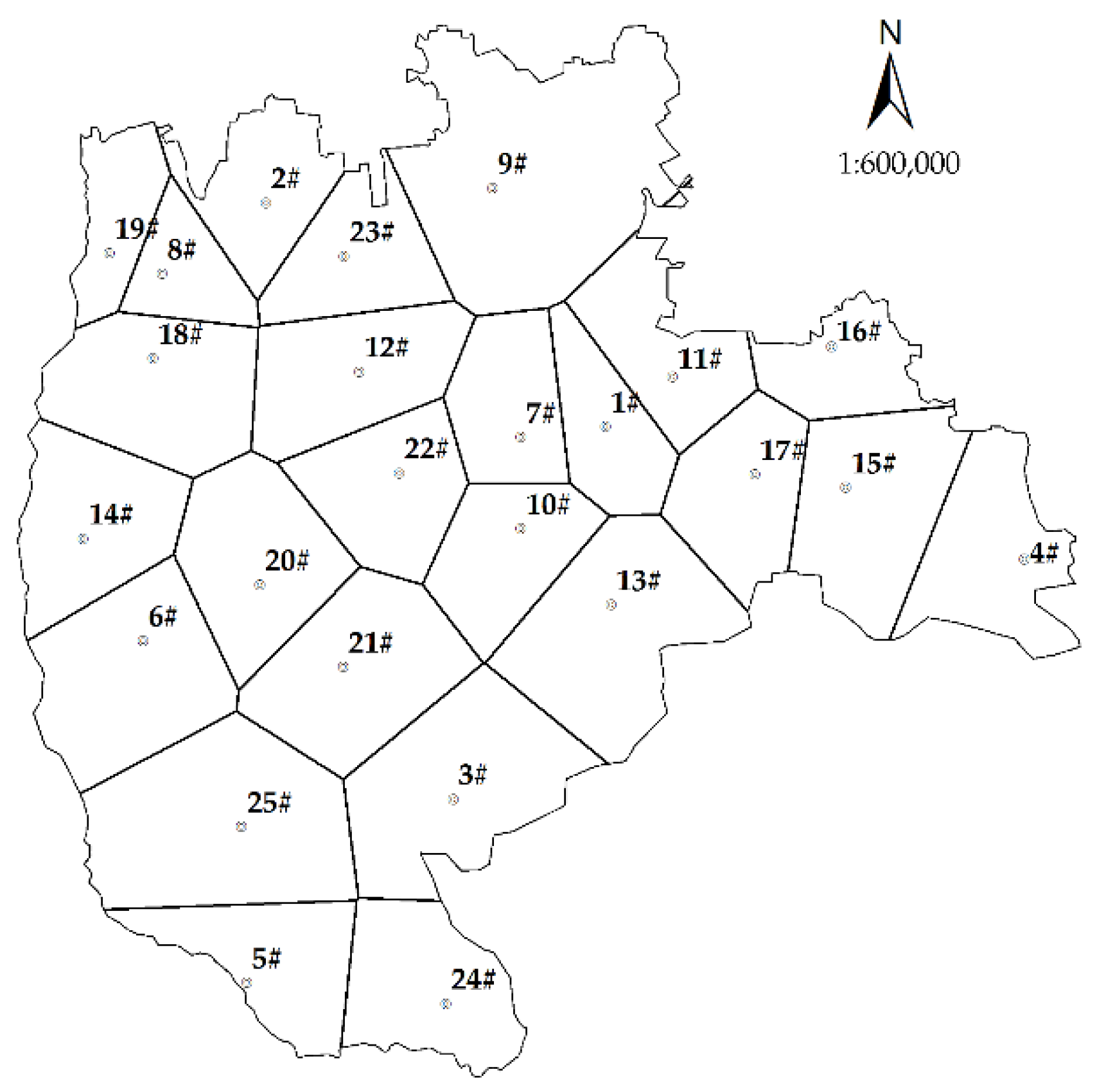
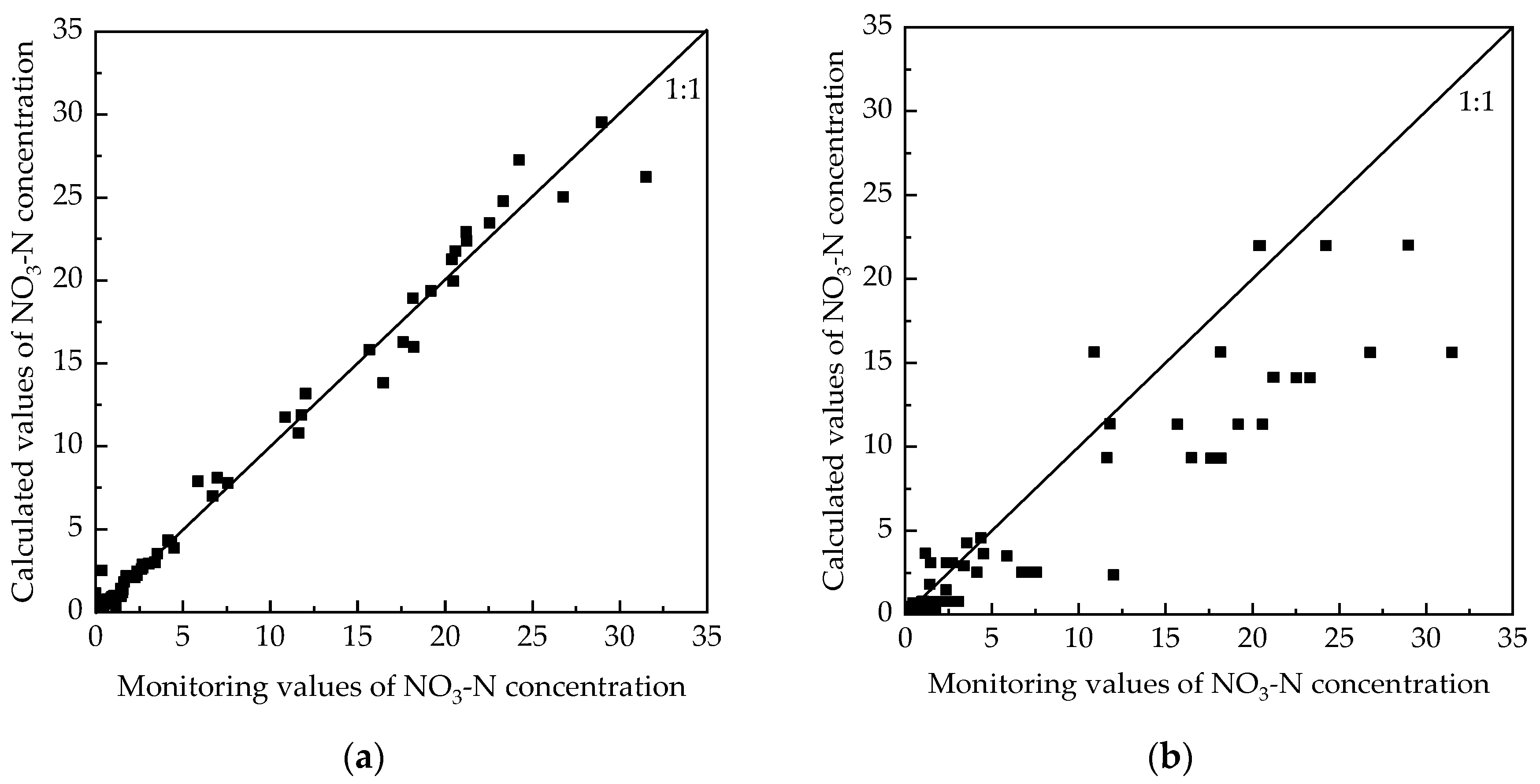
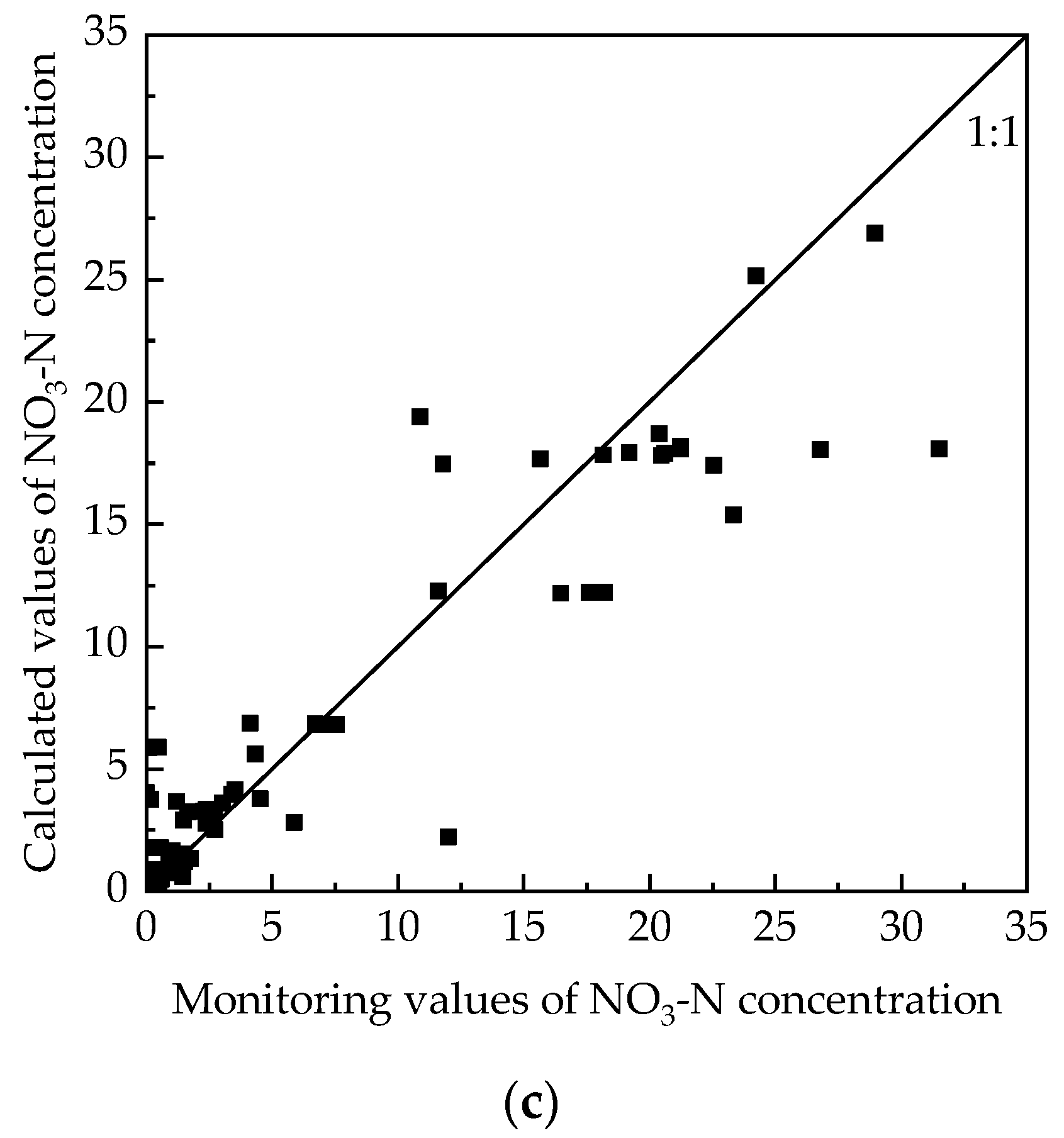
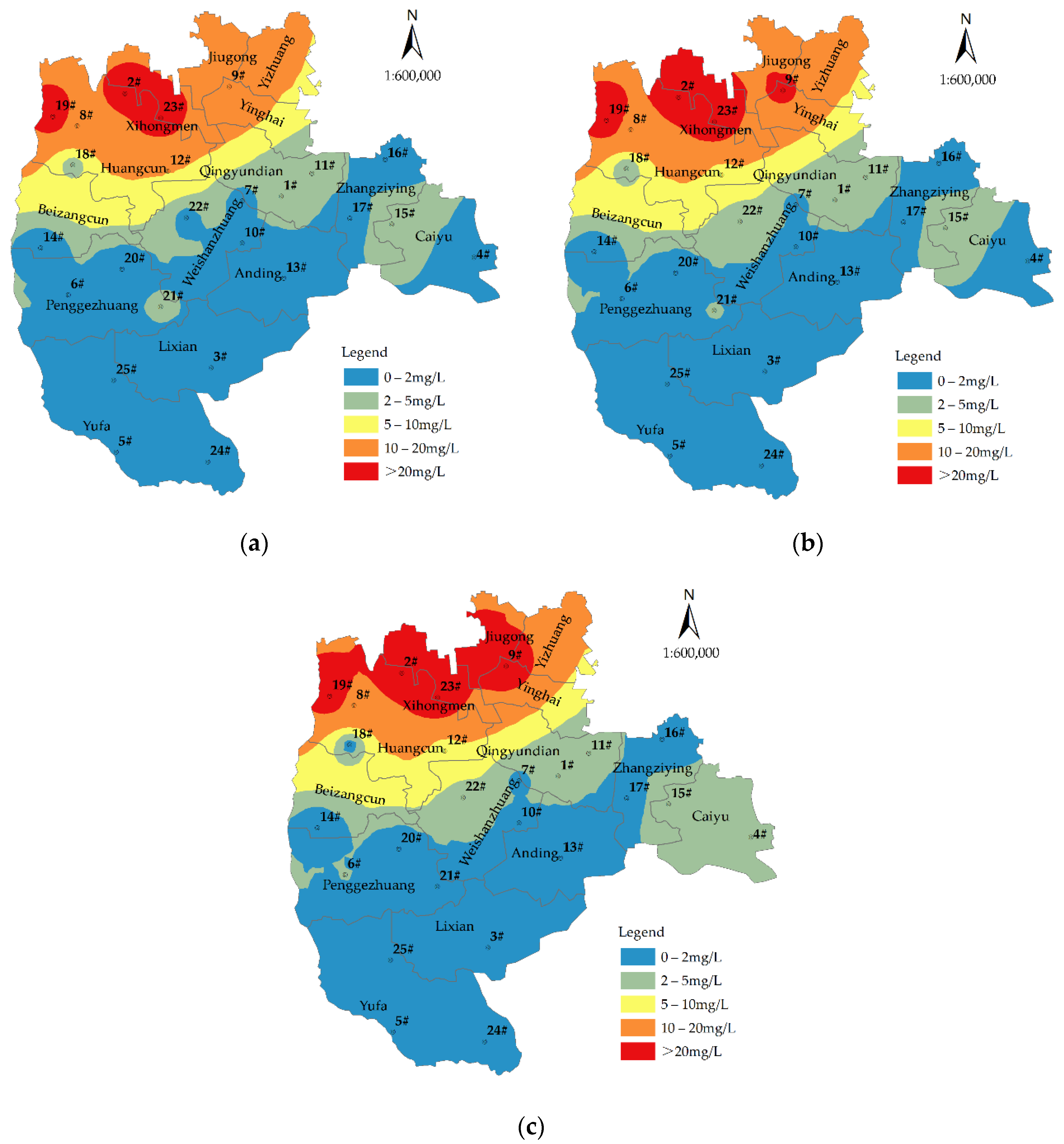
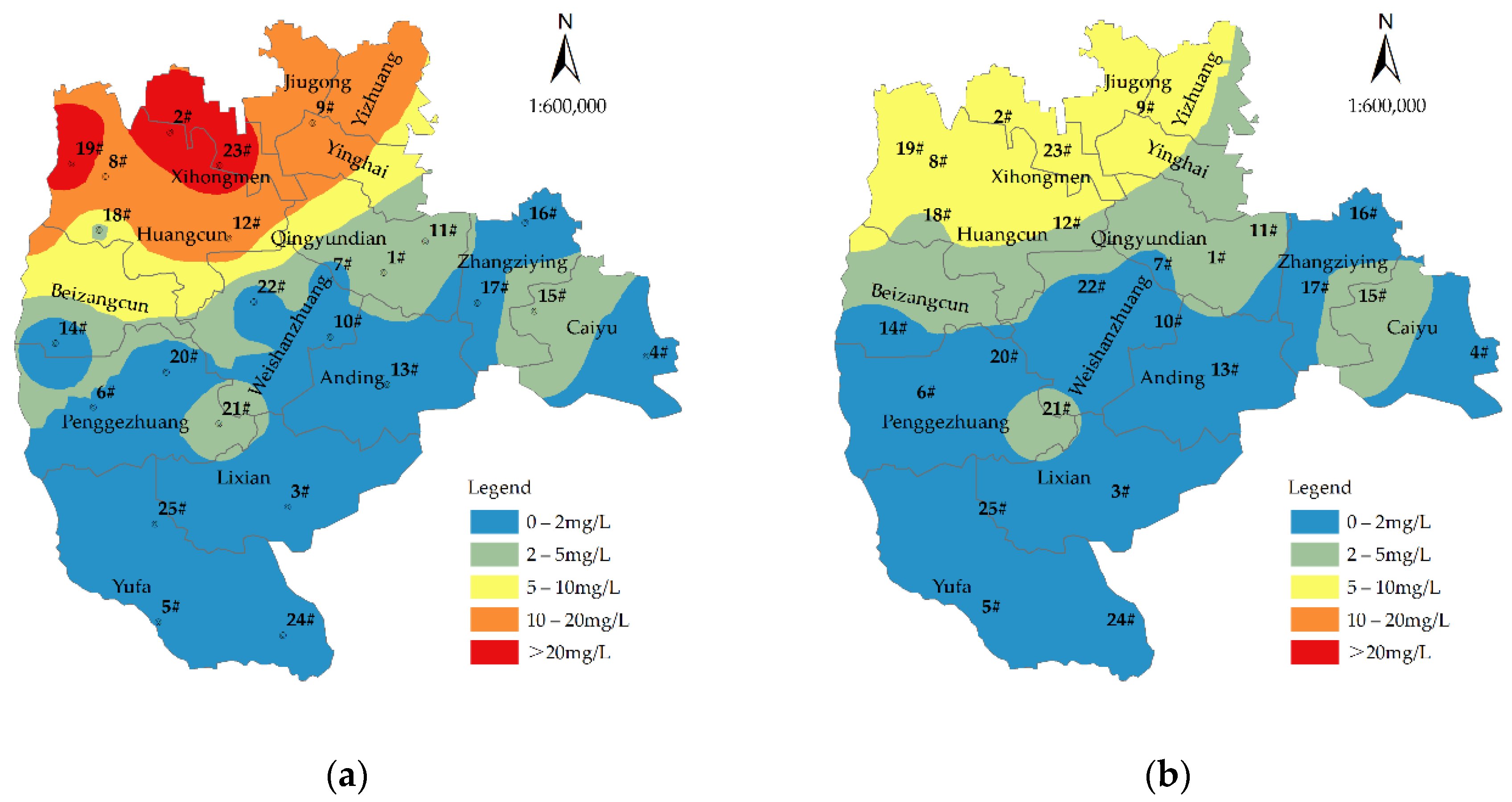
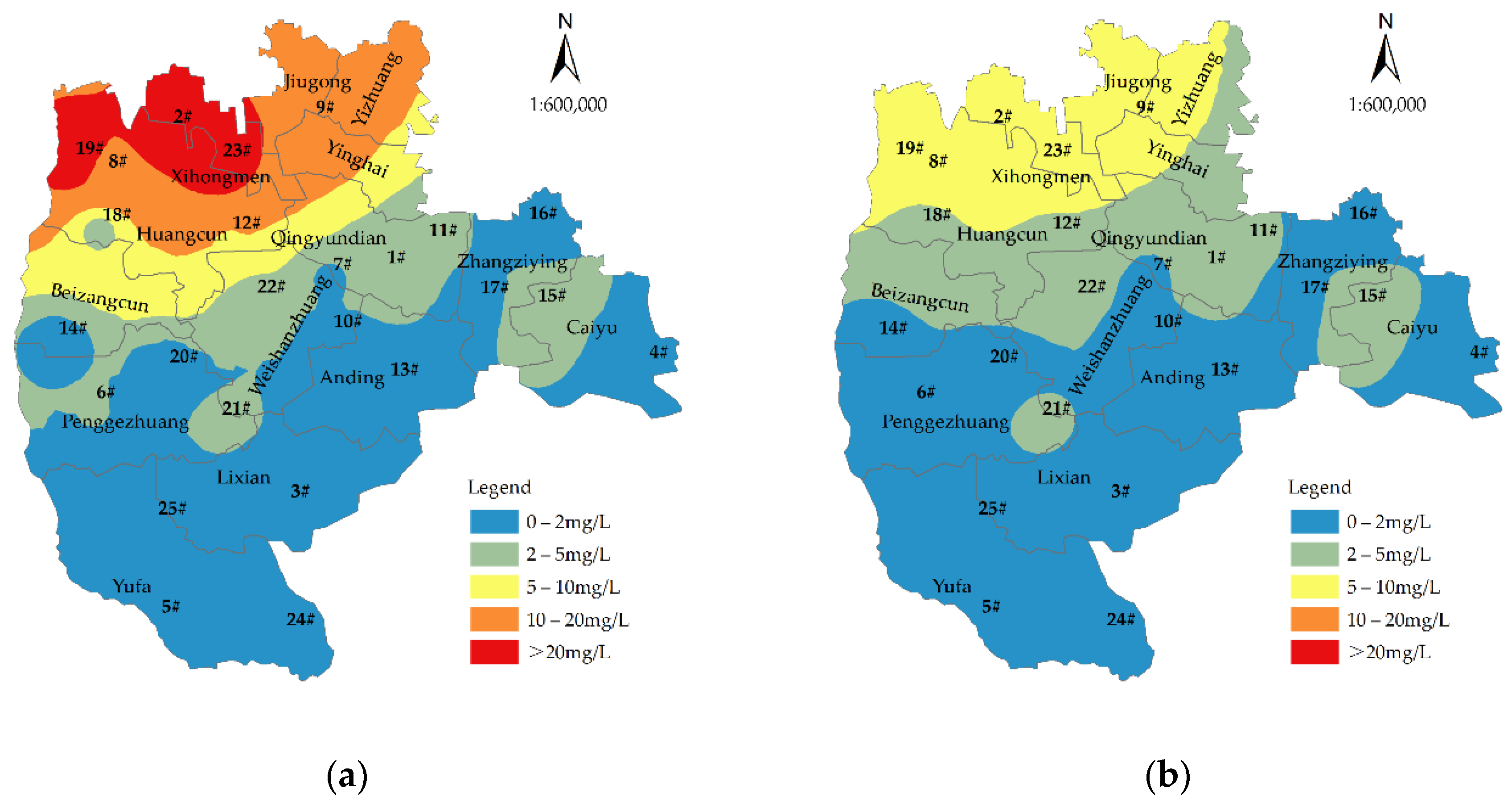
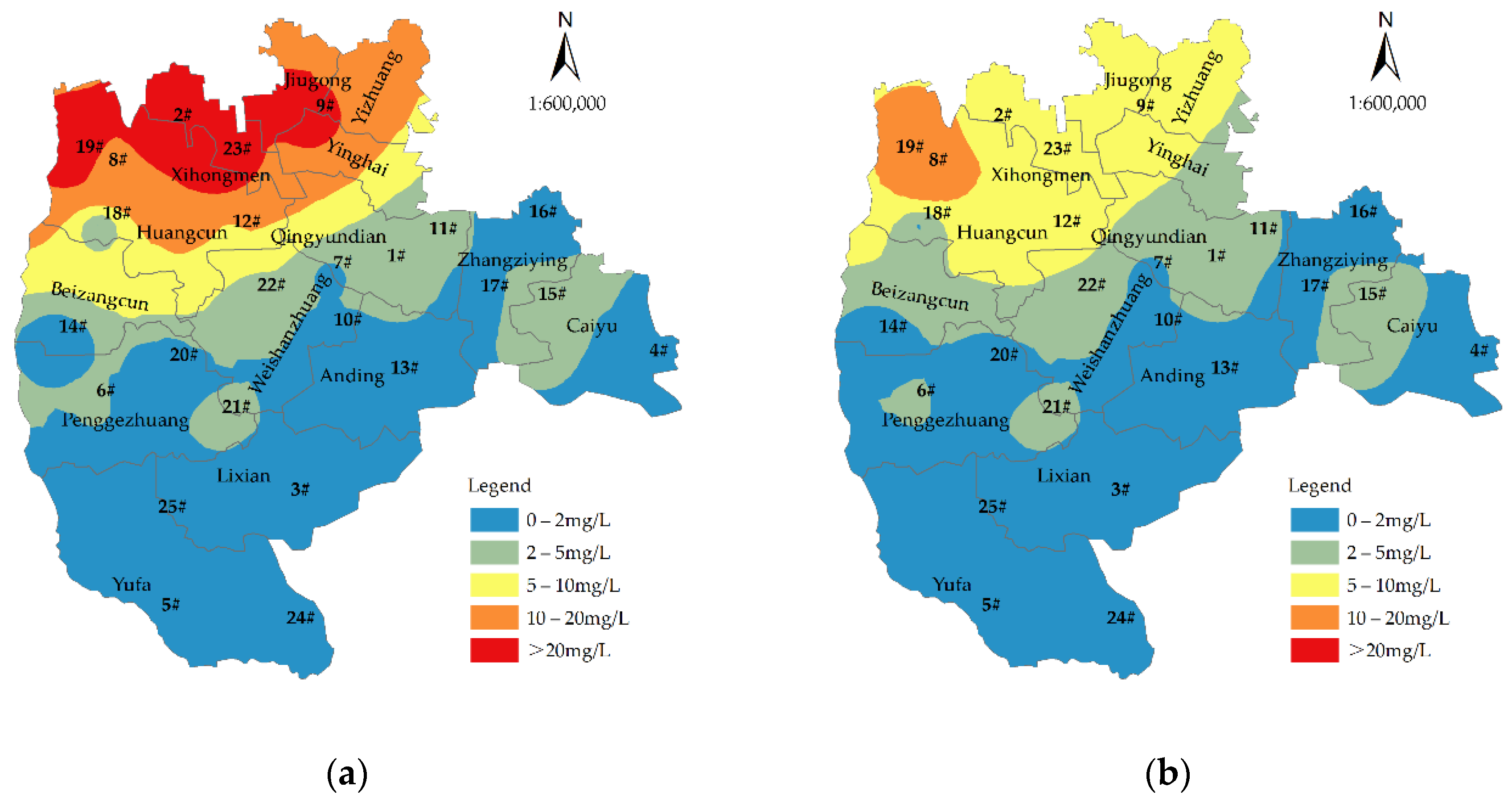
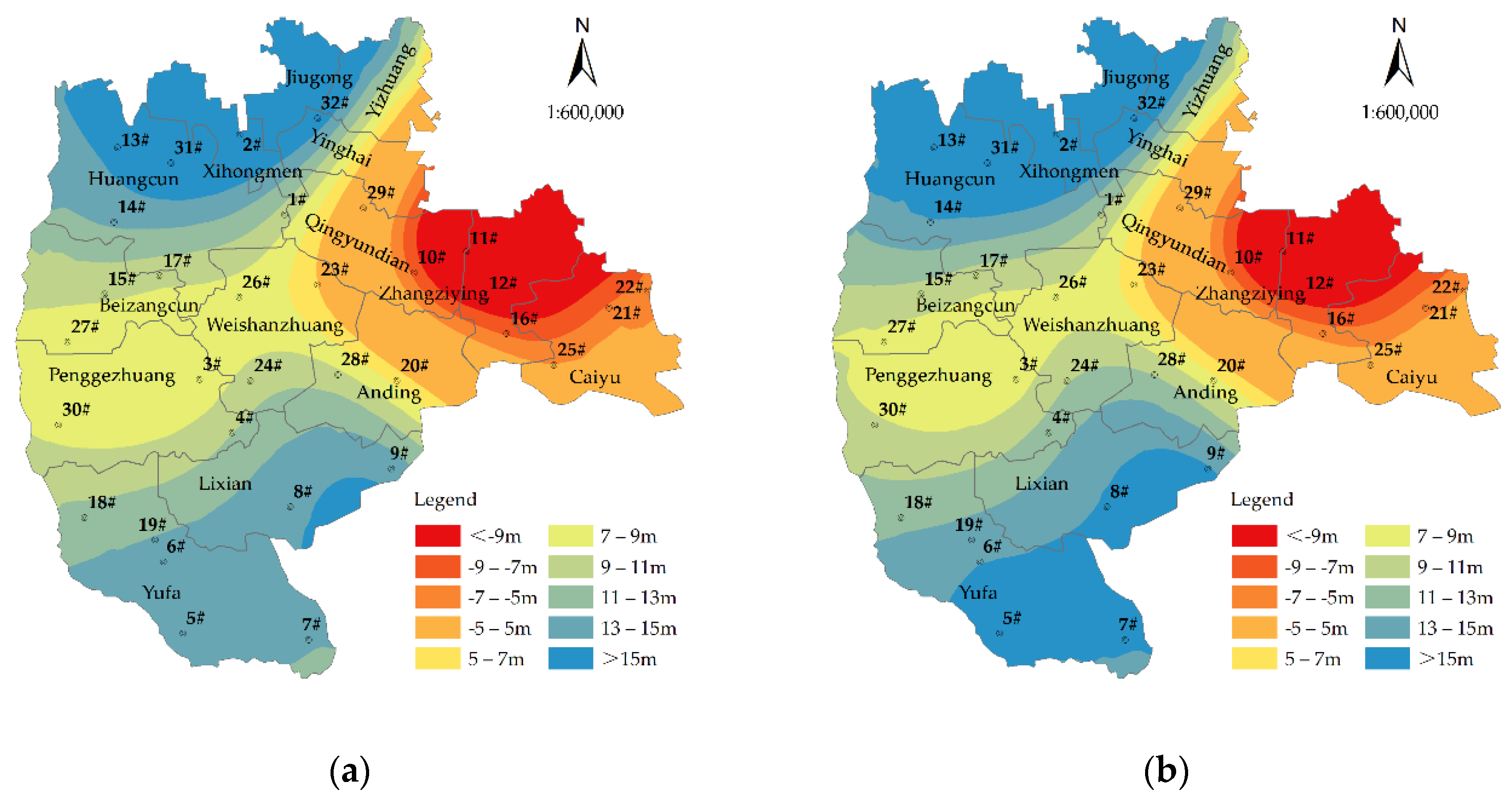
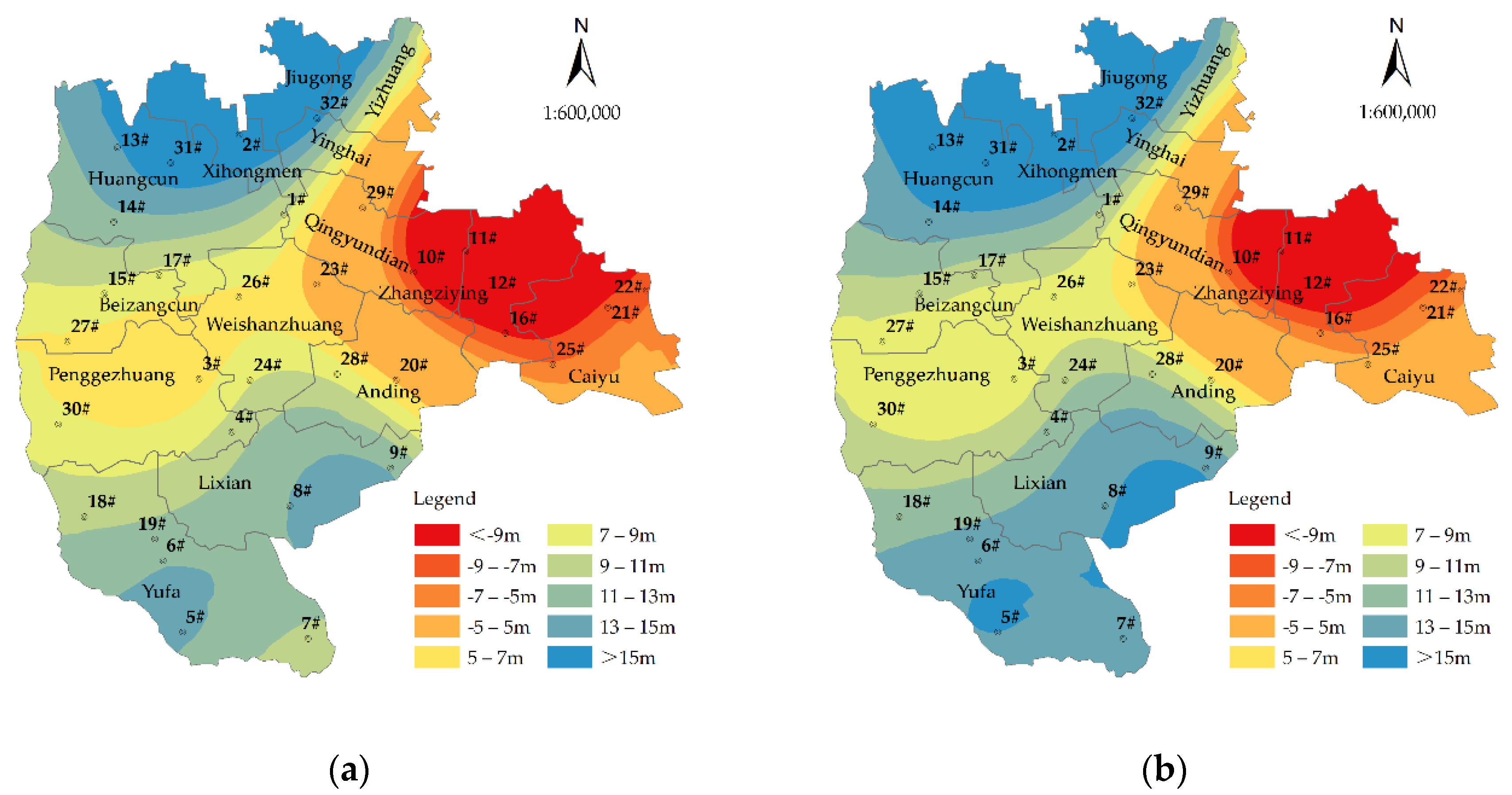
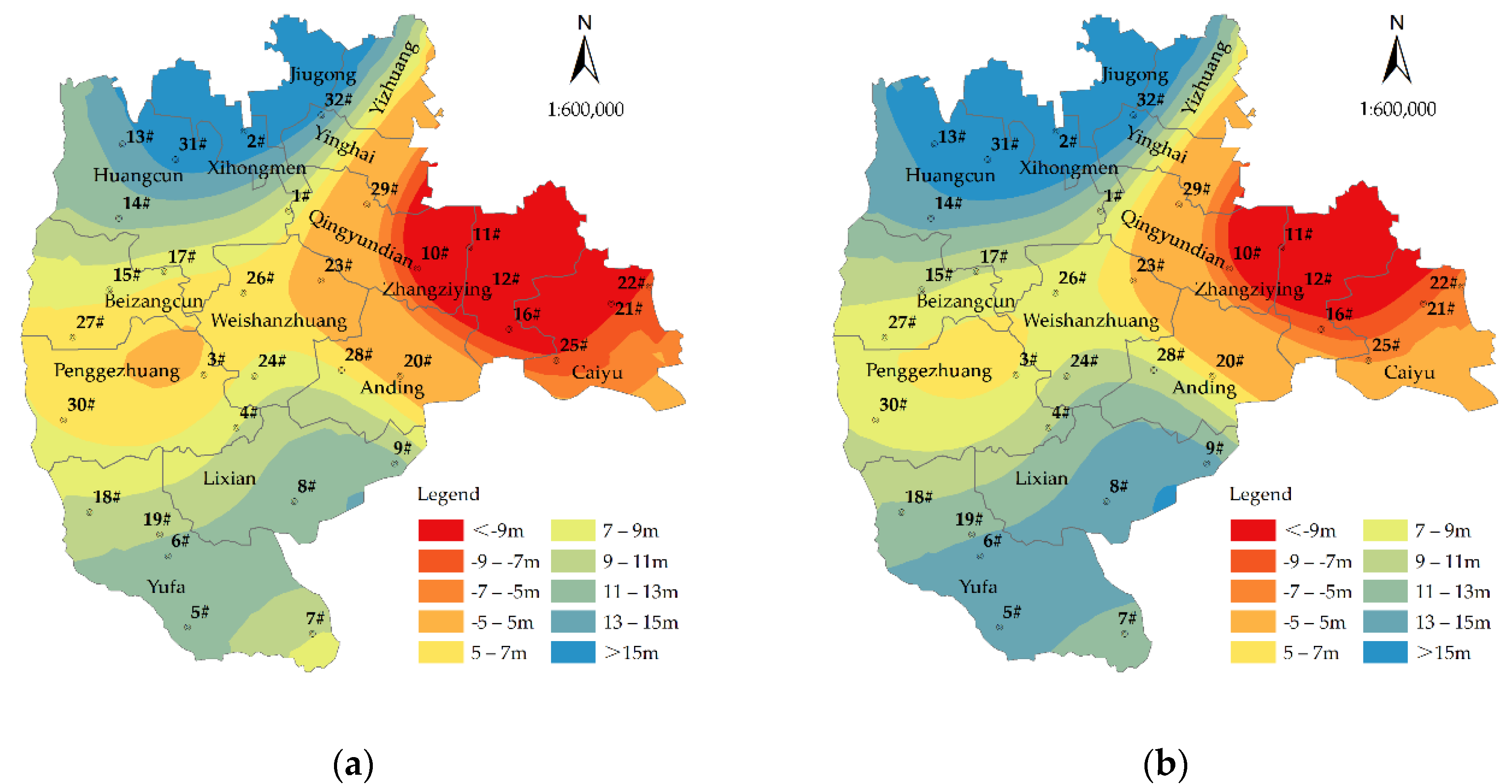
| Parameter Partition Number | Zone Area (km2) | Permeability Coefficient K (m/d) | Specific Yield μ |
|---|---|---|---|
| Zone I | 532.10 | 15–25 | 0.20–0.26 |
| Zone II | 384.99 | 8–10 | 0.13–0.20 |
| Zone III | 118.91 | 10–15 | 0.10–0.15 |
| Source and Sink Items | 2015 (104 m3) | 2016 (104 m3) | 2017 (104 m3) | 2018 (104 m3) | 2019 (104 m3) | 2020 (104 m3) |
|---|---|---|---|---|---|---|
| Atmospheric precipitation infiltration recharge | 15,699.30 | 20,928.10 | 15,955.23 | 14,423.30 | 12,782.17 | 14,346.22 |
| River infiltration recharge | 2230.10 | 3032.80 | 2278.90 | 2060.09 | 1825.69 | 2049.08 |
| Well irrigation return recharge | 2732.10 | 2580.60 | 2388.00 | 2143.80 | 2164.00 | 1472.00 |
| Groundwater lateral inflow | 376.20 | 530.00 | 403.9024 | 365.12 | 323.58 | 363.17 |
| Artificial exploitation | 21,672.50 | 21,390.73 | 20,618.63 | 18,791.62 | 19,493.98 | 15,507.55 |
| Groundwater lateral outflow | 103.00 | 145.10 | 108.35 | 97.95 | 86.80 | 97.43 |
| Changes in groundwater storage | −737.80 | 5535.67 | 299.05 | 102.74 | −2485.34 | 2625.49 |
| Parameter Zone | Zone Area (km2) | Permeability Coefficient K (m/d) | Specific Yield μ |
|---|---|---|---|
| Zone I | 532.10 | 15.4 | 0.25 |
| Zone II | 384.99 | 9.95 | 0.20 |
| Zone III | 118.91 | 11.7 | 0.105 |
| Hydrological Year Type | The Maximum Available Groundwater Volume before Reduction (104 m3) | Groundwater Exploitation Regime 1 (104 m3) | Groundwater Exploitation Regime 2 (104 m3) | Groundwater Exploitation Regime 3 (104 m3) | |||
|---|---|---|---|---|---|---|---|
| Reduction in the Amount of Groundwater Extraction | The Available Groundwater Volume | Reduction in the Amount of Groundwater Extraction | The Available Groundwater Volume | Reduction in the Amount of Groundwater Extraction | The Available Groundwater Volume | ||
| Wet year | 22,450.66 | 981.46 | 21,469.20 | 4798.73 | 17,651.93 | 5644.82 | 16,805.84 |
| Normal year | 18,086.54 | 1540.95 | 16,545.59 | 4868.98 | 13,217.56 | 5578.20 | 12,508.34 |
| Dry year | 1,4931.44 | 2549.68 | 12,381.76 | 5037.4 | 9894.04 | 5611.83 | 9319.61 |
| Hydrological Year Type | Groundwater Exploitation Regime | Water Shortage (104 m3) | Amount of Groundwater Used (104 m3) | The Maximum Amount of Groundwater Available (104 m3) | Groundwater Utilization Rate | NO3-N Maximum Concentration (mg/L) |
|---|---|---|---|---|---|---|
| Wet year | Current groundwater exploitation regime | 0 | 21,456.09 | 22,450.66 | 95.57% | 27.15 |
| Groundwater exploitation regime 1 | 0 | 16,630.11 | 22,450.66 | 74.07% | 13.32 | |
| Groundwater exploitation regime 2 | 0 | 16,630.11 | 22,450.66 | 74.07% | 12.00 | |
| Groundwater exploitation regime 3 | 0 | 16,630.11 | 22,450.66 | 74.07% | 10.64 | |
| Normal year | Current groundwater exploitation regime | 0 | 21,456.09 | 18,086.54 | 118.63% | 28.24 |
| Groundwater exploitation regime 1 | 0 | 16,545.59 | 18,086.54 | 91.48% | 17.63 | |
| Groundwater exploitation regime 2 | 0 | 13,217.56 | 18,086.54 | 73.08% | 11.52 | |
| Groundwater exploitation regime 3 | 0 | 12,508.34 | 18,086.54 | 69.16% | 11.02 | |
| Dry year | Current groundwater exploitation regime | 0 | 23,038.39 | 14,931.44 | 154.29% | 28.55 |
| Groundwater exploitation regime 1 | 0 | 12,381.76 | 14,931.44 | 82.92% | 17.72 | |
| Groundwater exploitation regime 2 | −2440.86 | 9894.04 | 14,931.44 | 66.26% | 10.85 | |
| Groundwater exploitation regime 3 | −3015.29 | 9319.61 | 14,931.44 | 62.42% | 10.14 |
Publisher’s Note: MDPI stays neutral with regard to jurisdictional claims in published maps and institutional affiliations. |
© 2022 by the authors. Licensee MDPI, Basel, Switzerland. This article is an open access article distributed under the terms and conditions of the Creative Commons Attribution (CC BY) license (https://creativecommons.org/licenses/by/4.0/).
Share and Cite
Li, C.; Men, B.; Yin, S.; Zhang, T.; Wei, L. Research into the Optimal Regulation of the Groundwater Table and Quality in the Southern Plain of Beijing Using Geographic Information Systems Data and Machine Learning Algorithms. ISPRS Int. J. Geo-Inf. 2022, 11, 501. https://doi.org/10.3390/ijgi11100501
Li C, Men B, Yin S, Zhang T, Wei L. Research into the Optimal Regulation of the Groundwater Table and Quality in the Southern Plain of Beijing Using Geographic Information Systems Data and Machine Learning Algorithms. ISPRS International Journal of Geo-Information. 2022; 11(10):501. https://doi.org/10.3390/ijgi11100501
Chicago/Turabian StyleLi, Chen, Baohui Men, Shiyang Yin, Teng Zhang, and Ling Wei. 2022. "Research into the Optimal Regulation of the Groundwater Table and Quality in the Southern Plain of Beijing Using Geographic Information Systems Data and Machine Learning Algorithms" ISPRS International Journal of Geo-Information 11, no. 10: 501. https://doi.org/10.3390/ijgi11100501
APA StyleLi, C., Men, B., Yin, S., Zhang, T., & Wei, L. (2022). Research into the Optimal Regulation of the Groundwater Table and Quality in the Southern Plain of Beijing Using Geographic Information Systems Data and Machine Learning Algorithms. ISPRS International Journal of Geo-Information, 11(10), 501. https://doi.org/10.3390/ijgi11100501






